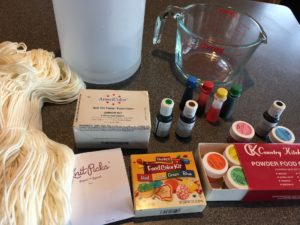
In today’s yarn world, there are thousands of people dyeing yarn at home and achieving wild and interesting (and sometimes, even beautiful) results. Have you ever wanted to try your hand at dyeing your own yarn, but were too intimidated? Or, perhaps you just didn’t want to shell out money for an expensive set of professional equipment and dyes.
In this video, I share a way that you can create hand-dyed yarn using materials that you probably already have in your kitchen. The main ingredients are vinegar and food dye, and with just a little time and patience you can use these to make your own fun and creatively-colored yarns.
Materials
Undyed yarn
Be sure to select yarn that is composed of protein fibers: wool, alpaca, silk, mohair, or any combination of these. Check with your local shepherd or yarn shop to see if they have undyed yarn for sale. If not, you can order online from suppliers such as KnitPicks, Webs, or Wool 2 to Dye 4.
Food coloring
Available in supermarkets, specialty baking suppliers, and even sold seasonally as in the Easter egg dye tablets, dyes come in different forms. Choose a gel or powdered form for more concentrated tones.
White vinegar or citric acid
You probably already have white vinegar in your pantry, or if not it’s available very inexpensively from any supermarket or convenience store. Citric acid is a little more difficult to find (available online if you can’t find it at your local store) but more concentrated if you plan to dye several skeins of yarn.
Heat-safe vessels and utensils for measuring, mixing, and soaking
I prefer heavy glass bowls or measuring cups, but you can also use stainless steel pots.
Instructions
Soak your yarn in warm water for 15-20 minutes to be sure it’s thoroughly whetted. (Dye won’t uptake evenly onto dry yarn.)
While the yarn is soaking, measure out your dye(s) into vessels and dilute them with very hot water. Use two cups of hot water per vessel, leaving plenty of space so that you can add your yarn. If you are using powdered dye, be sure to mix the powder very thoroughly so the dye dissolves completely in the water before you add the yarn.
Add the acid mordant to the dye vat(s). For vinegar, I use about a half cup per dye vat. For citric acid, start with a tablespoon of powder and stir to make sure it’s thoroughly dissolved.
Gently lift your wet yarn out of the soaking container and squeeze gently, then place the yarn in your dye vat(s). Immediately poke the yarn under the surface and press or stir gently so that the yarn is completely submerged and begins to take up the dye. Let the yarn soak in the dye vat for an hour, then check it by inserting a clean spoon into the dye water. If the water looks clear on the spoon, the dye has adhered to the yarn well. If there is a lot of color left in the water, add more acid and reheat the dye bath to help the bonding process.
Note that the amount of water used doesn’t really matter (as long as you’re not overfilling vessels and making a mess). The water is the medium that the dye travels through to get to the yarn, but the amount of water won’t affect the color. It’s the concentration of dye in proportion to the amount of yarn that affects color intensity.
When the water looks clear you can be sure the dye has bonded with the yarn, but I like to leave my skein soaking overnight to ensure the color won’t rinse out. Rinse the yarn gently the next morning in warm water (use a little wool wash if desired). Then squeeze out the excess water and hang your skein to dry.
Some techniques to try:
Solid: see how smooth and uniform a color you can make by ensuring your dye vat is well mixed and your yarn is evenly whetted.
Variegated: add concentrated dye directly to the dye vat and don’t stir.
Self-striping: drape one skein into two vats simultaneously.
Gradient: Mix up 3 or 4 different shades in mason jars. Wind one skein into consecutive sections (tie each section loosely to prevent tangling) and dip each section into a different mason jar.
Speckled: Wet the yarn with hot water mixed with acid, then transfer the hot yarn to a sheet of plastic wrap. Sprinkle powdered dye directly onto the wet yarn, then roll the skein up in wrap and re-heat it to set the dye.
Other videos
Dyeing a Hand Wound Ball of Yarn for a Fun Gradient
How to Dye Yarn with Kool-Aid (hand-painting multiple colors)
